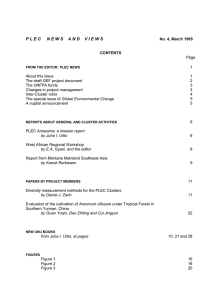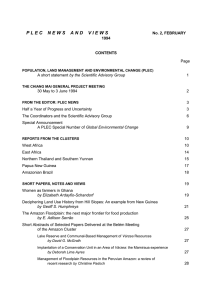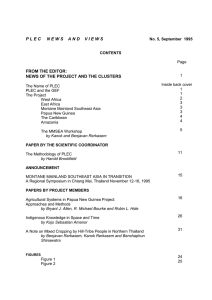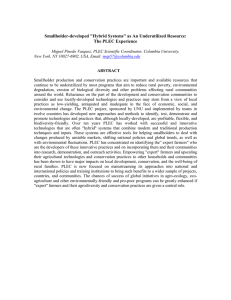“ Hybrid systems ” developed by
advertisement
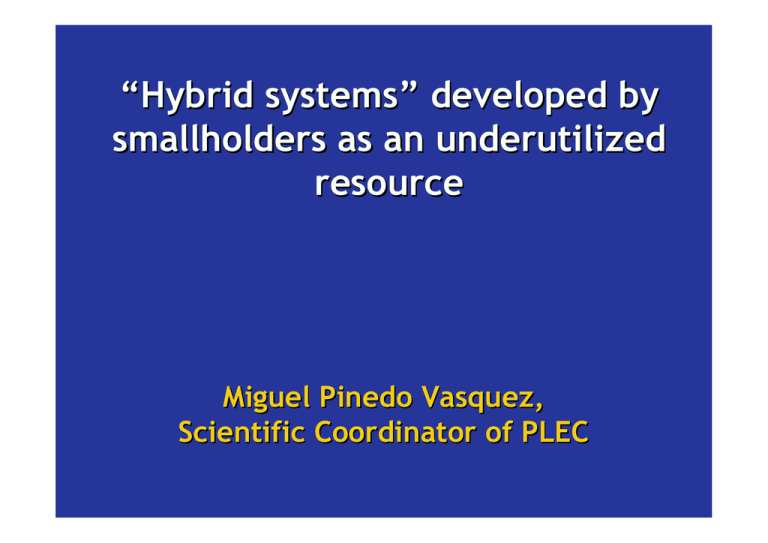
“Hybrid systems” developed by smallholders as an underutilized resource Miguel Pinedo Vasquez, Scientific Coordinator of PLEC The global challenge of rural development z provide food security z reduce rural poverty z reduce environmental degradation z stem the erosion of biological diversity Two paths to achieving global goals: z z Apply modern technologies and systems that have succeeded in industrialized countries Use “traditional” systems and technologies Some problems with applying industrialized country solutions z z z Tools and other inputs are expensive and most farmers can not afford them Modern systems are mainly developed for the production of a single crop and this exposes poor farmers to unacceptable risks Small farmers often farm areas unsuitable (slopes, flood-prone lands, etc.) for farming with developed country technologies Problems with “traditional” systems. Many view traditional systems as: z low-yielding, inefficient z antiquated, bound by tradition z non-adaptive and non- adaptable when facing economic, social, and environmental change The result of these assumptions: • reluctance of development and conservation communities to incorporate local agricultural practices • the most important, available, resource of rural communities— knowledge—continues to be underutilized What solutions does PLEC offer? We identify, test, and promote locallydeveloped “hybrid” systems that combine traditional knowledge and approaches with new knowledge, technologies, tools, and economic understanding “Hybrid” technologies help farmers to deal with environmental changes Average income made by 22 families from 1998 a 2000, Iquitos, Peru 900 800 700 flood dry 600 500 400 300 200 100 0 fields h.gardens forests others QuickTime™ and a Photo - JPEG decompressor are needed to see this picture. QuickTime™ and a Photo - JPEG decompressor are needed to see this picture. QuickTime™ and a Photo - JPEG decompressor are needed to see this picture. 9 8 7 7 8 9 10 11 12 6 5 4 3 2 1 0 7 8 9 10 11 12 “Hybrid” systems help farmers to deal with market changes and oportunities Price fluctuation of cassava per hours in the markets of Macapa, Brazil in February, 2002 30 25 20 15 10 5 0 Average number of agriculture products sold by 15 families in the markets of Macapa, Brazil in five years (1998 - 2002) Changes in rural development priorities at global, regional and national levels Coffee economy collapsed in Kenya Some examples of “hybrid” technologies and systems developed by farmers A “hybrid” biodiversity-friendly and profitable system for timber and food production in Tanzania A system that integrates modern forestry with traditional farming practice z z z New tree species (including some exotic trees) New planting patterns recommended by foresters Recreates traditional patterns for cultivating wild vegetables and crops 60 50 40 30 20 10 0 trees crops wild veg New locallydeveloped seed storage technologies using waste oil developed by caboclos in Brazilian Amazonia Colheita e armazenamento Milho no tijuco ou lama Dicas para se guardar o milho para semente e para criação: Colheita: Logo após a colheita: Fazer o atilho. Como? Pegase 2 espigas, retira -se algumas palhas deixando outras para proteção e amarra-se uma na outra. Como saber que está na hora certa de colher o milho? “Quando vai secando, vermelhando as folhas da árvore e a espiga também vão ficando vermelhinha” (D. ChicaMarirana) Faça como o Sr. Minerval e a D.Chica e o Sr.Raimundo e a D.Alcilene (Marirana): Procure quebrar o milho quando estiver na época de noite escura, sem luar. Isso ajuda a afugentar os gorgulhos! 25 atilhos = 1 mão = 50 espigas E D. Guinelina (Marirana) avisa: Não se esqueçam de amarrar as pontas de cada milho, pois é por aí que entra o gorgulho! Atilho Para armazenar: D.Alcilene, D.Chica, D.Guinelina (Marirana) e D.Luzia (Aiucá) recomendam: Se for guardar o milho para semente, você deve guardar no sol ou no fumaceiro (do fogão à lenha, por exemplo). Isto também ajuda a afastar os gorgulhos! D.Guinelina com seu milho no sol Milho no fum aceiro 30 25 20 hybrid system other 15 10 5 0 corn beans peanuts Average time of storing corn, bean and peanut seeds using the “hybrid” system and other methods by 25 families (1998-2002) These hybrid systems help smallholders deal with changes produced by unstable markets, shifting national policies, and global trends These systems can raise rural incomes: Average annual income (US$) made from managed fallows using a “hybrid” agroforestry system promoted by PLEC in Brazil 2002 2000 1999 0 200 400 600 800 1000 PLEC facilitates the spread of these innovative hybrid technologies and systems that combine modern and traditional production knowledge and inputs through a tested set of “demonstration” activities How does PLEC work? PLEC identifies the “expert farmers,” developers of innovative practices and incorporates them and their communities into rural research, demonstration, and outreach z z PLEC uses a great variety of demonstration approaches PLEC uses demo sites in the landholdings of expert farmers to facilitate the exchange of knowledge among farmers PLEC dissemination methods are tested and effective Families that adopted the expert farmer “hybrid” agriculture system after participating in demonstration activities in 6 communities, Ghana 350 300 250 200 practicing non-practicing 150 100 50 0 1999 2000 2001/02 PLEC provides a unique network for South-South cooperation and SouthNorth twinning arrangements Collaboration between 19 institutions 6 PLEC clusters in 12 highly biodiverse countries Results of PLEC • More appropriate local development • Enhanced well-being of rural families • Pro-poor environmental conservation Results of PLEC: environmental benefits • Lowering use of chemicals • Increasing use of local varieties and the value of agrodiversity • Using sustainable production methods that maintain ecosystem function The future of PLEC PLEC is now focussed on mainstreaming its approaches into national and international policies and training institutions to bring such benefits to a wider sample of projects, countries, and communities Conclusions • ”Expert" farmers and their “hybrid systems” offer local solutions to some of the most pressing problems of poverty and environmental degradation • PLEC offers a sustainable future to agricultural communities worldwide
